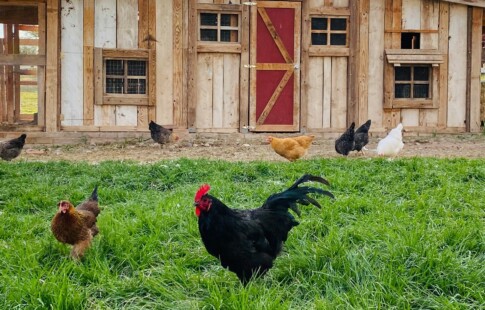
How Overfarming Affects the Environment
We are reader-supported. When you buy through links on our site, we may earn affiliate commission.
The agriculture industry plays a critical role in today’s global economy. It supports the livelihoods of farmers and ranchers, provides food and raw materials for consumers and businesses and builds a strong economy through trade.
Large-scale industrial farming contributes to the worsening state of the environment, especially if farmers are overfarming their land. What is overfarming, what effects does it have on the environment and what solutions can help farmers avoid overfarming?
What is Overfarming?
Overfarming, over-cultivation and intensive farming, as their names suggests, involves using excessive farming practices on a portion of land. Essentially, overfarming occurs when crops grow on the same piece of farmland too many times without any breaks. Productivity on a farm can decrease significantly if land is overfarmed.
Overfarming can deplete soil’s nutrients and, if severe enough, makes it nearly impossible to grow anything on that piece of land, which is called soil sterilization. Without fertile soil to grow and harvest with, farmers’ yields can significantly decrease.
Causes of Overfarming
There are a few reasons why overfarming can occur, and each one of them can play a role in the degradation of land and soil. Here are some of the primary causes of overfarming in the agriculture sector.
Overpopulation and Rising Demand for Agricultural Products
To an extent, many of the issues the agriculture industry faces are caused by the skyrocketing global population. According to Statista, the world population will reach 8.55 billion by 2030. A growing population poses unprecedented challenges to farmers, as they must produce more crops and raw materials to meet rising demand
Using Too Much Fertilizer or Pesticides
Another factor causing overfarming in industrial agriculture is the excessive use of pesticides and fertilizers. These chemicals serve as an artificial way of making soil more nutrient dense, which can lead to higher crop yields. However, overuse of pesticides and fertilizers causes soil to become saturated, damaging the soil structure and leading to soil degradation.
Reduced Farmland Availability
According to National Geographic, more than half of the world’s land is used for cultivation of crops. Because there is a reduced amount of farmland available for growing crops, farmers will continue growing crops on the same pieces of land over and over again. This constant reuse of land can quickly turn into a case of overfarming.
How Overfarming Affects the Environment
Overfarming can spark a vicious cycle where farmers cannnot use their farmland to grow gropsand produce high yields. While decreased yieldsmay impact an individual farmers’ profitability, it can also have far-reaching, negative effects on the environment.
Soil Degradation
Soil degradation is the loss of land’s capacity to produce crop yields and occurs due to loss of soil fertility and biodiversity. A 2019 report from the United Nations found that 24 billion tons of fertile land across the world is lost every year. Excessive soil degradation leads to desertification, which brings about a whole host of other issues. Some of the damage caused by soil degradation can even be permanent.
Deforestation
Another effect of overfarming is deforestation. As mentioned earlier, there’s a limited amount of farmland available for professional in the agriculture industry, meaning they’ll do what it takes to create more land for cultivation, even if it means tearing down forests.
Water Pollution
The pesticides and fertilizers used to replenish soil can lead to degradation, but it can also end up in nearby waterways. Water is a valuable resource, and when chemicals or eroded soil enter waterways, it can cause sediments to accumulate. The agriculture industry is no stranger to water pollution, but it can be challenging to contain runoff from entering waterways.
Loss of Biodiversity
When water is polluted from nearby farms, it can lead to a loss of biodiversity in the surrounding environment, both on land and in waterways. Additionally, increases in water pollution can lead to increases algae growth, otherwise known as cultural eutrophication. A loss of biodiversity has far-reaching consequences for humans, as it can lead to less food production, affect livelihoods and can even cause political conflict.
Food Insecurity
Overfarming can also contribute to the rising issue of global food insecurity. Without enough fertile farmland to grow crops, it’s challenging for farmers to continually meet crop yields, thus impacting the food supply chain. During the pandemic, it was reported that there were 118 more people fighting hunger and undernourishment rose from 8.4% to 9.9%. Food insecurity is already a major issue around the world, and overfarming only exacerbates it.
Human Health Hazards
As intensive farming continues to take place in the agriculture sector, it can actually cause more human health problems for society. According to a paper from PNAS, epidemics may become more common due to overfarming. Based on the research in the paper, there seems to be a strong correlation between intensive livestock production and the emergence of bacteria pathogens, which can cause harm to humans.
3 Potential Solutions for Over-Cultivation
Because overfarming has such negative effects on the environment, it’s important for industry leaders, farmers and innovators to work together to find feasible solutions. Finding the right solutions to overfarming can help reduce the likelihood of these negative effects on the environment destroying the only place we have to call home.
1. Implement Sustainable Agriculture
The best way farmers can avoid overfarming their land is to implement sustainable agriculture practices. For example, farmers can focus on crop rotation, where they grow different types of crops on the same land annually.
This can give the soil time to heal and avoid erosion or degradation. Additionally, farmers should consider the shape and slope of the land during ploughing, which can also minimize soil erosion and prevent excessive loss of water, a critical resource in virtually all agricultural approaches.
2. Use a Precision Farming Approach
Another potential solution to overfarming is leveraging a precision farming approach. Precision farming uses new and emerging technologies, such as the Internet of Things (IoT), to ensure crops and soil receive exactly what they need to thrive and be productive.
Precision farming can help ensure farmers’ profitability, sustainability and can have less of an impact on the environment. More precise farming practices can reduce some of the negative effects of overfarming described above.
3. Investing in Perennial Grain Crops
The agriculture industry should have the ultimate goal of creating and maintaing sustainable production systems, as it ensures profitability and food security for years to come. One method The Land Institute is developing is the use of perennial crops.
These crops do not need to be reseeded or replanted every year. They also:
- Are robust enough to protect soil from erosion
- Can improve soil structure
- Do not require herbicide application
- Reduce the need for significant inputs for farmers
Perennial crops alone cannot help farmers avoid overfarming, but they’re certainly a step in the right direction.
These are only a few of the potential solutions farmers and the general agricultural community can adopt to reduce the need to overfarm land.
Protecting Land for Future Generations
The issue of overfarming cannot be understated — it has negative effects on the environment, leads to food insecurity and can have disastrous consequences on nearby animal life. It’s important for today’s agricultural communities to focus on implementing solutions that can help them avoid overfarming, as its cons outweigh the benefits.
As time goes on, the large-scale agriculture industry will need to innovate, adopt new technologies and support farmers and ranchers trying to make a living and provide resources for their communities.
Share on
Like what you read? Join other Environment.co readers!
Get the latest updates on our planet by subscribing to the Environment.co newsletter!
About the author
Jane Marsh
Starting from an early age, Jane Marsh loved all animals and became a budding environmentalist. Now, Jane works as the Editor-in-Chief of Environment.co where she covers topics related to climate policy, renewable energy, the food industry, and more.





